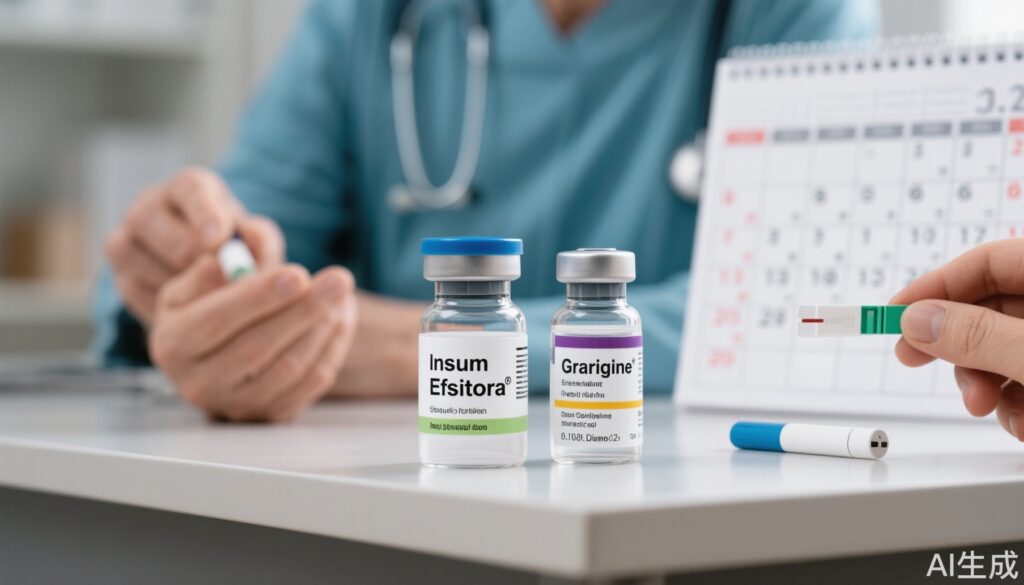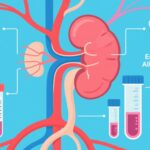Highlights
- Once-weekly insulin efsitora is noninferior to once-daily glargine for HbA1c reduction in insulin-naïve adults with type 2 diabetes.
- Efsitora is associated with fewer clinically significant and severe hypoglycemic events compared to glargine.
- Fixed-dose, less frequent titration with efsitora offers a streamlined regimen with reduced patient and provider burden.
- The trial supports a simplified approach to basal insulin initiation, with potential practice-changing implications.
Study Background and Disease Burden
Type 2 diabetes mellitus (T2DM) is a progressive metabolic disorder characterized by insulin resistance and declining beta-cell function, frequently leading to the need for exogenous insulin. While basal insulin remains a cornerstone for glycemic control when oral agents are insufficient, initiation is often delayed due to patient and provider concerns: injection burden, fear of hypoglycemia, and complexities of titration. Traditional basal insulins, such as insulin glargine, require daily dosing and frequent dose adjustment, typically at least weekly, guided by fasting blood glucose levels. This regimen can be challenging for both patients and healthcare systems, contributing to therapeutic inertia and suboptimal glycemic control.
Emerging once-weekly basal insulins, such as insulin efsitora alfa (efsitora), offer the potential to reduce injection frequency and simplify titration. However, robust evidence of efficacy and safety in insulin-naïve T2DM patients is essential for clinical adoption. The QWINT-1 phase 3 trial provides critical comparative data on this new therapeutic approach.
Study Design
This was a 52-week, phase 3, open-label, treat-to-target, randomized controlled trial (RCT) conducted in adults with T2DM who had not previously received insulin therapy.
– Population: 795 adults with T2DM inadequately controlled on oral agents, insulin-naïve.
– Interventions: 1:1 randomization to once-weekly efsitora (starting at 100 U, adjustable to fixed doses of 150, 250, or 400 U every 4 weeks) or once-daily insulin glargine U100 (dose titrated weekly or more frequently using a standard algorithm).
– Glycemic Target: Fasting blood glucose 80–130 mg/dL for both arms.
– Primary Endpoint: Change in glycated hemoglobin (HbA1c) from baseline to week 52 (noninferiority margin 0.4%).
– Key Secondary Endpoints: Incidence of clinically significant (glucose <54 mg/dL) or severe (level 3) hypoglycemia, insulin dose, and number of dose adjustments.
Key Findings
Glycemic Efficacy:
– Mean baseline HbA1c was 8.20% (efsitora) and 8.28% (glargine).
– At 52 weeks, HbA1c decreased to 7.05% (efsitora) and 7.08% (glargine).
– Least-squares mean changes: –1.19% (efsitora) vs –1.16% (glargine).
– Between-group difference: –0.03% (95% CI, –0.18 to 0.12), confirming noninferiority.
– Superiority was not demonstrated (P = 0.68).
Hypoglycemia:
– Clinically significant/severe hypoglycemia rate: 0.50 events/participant-year (efsitora) vs 0.88 (glargine).
– Rate ratio: 0.57 (95% CI, 0.39–0.84), favoring efsitora.
Insulin Dose and Titration Burden:
– Week 52 mean total weekly dose: 289.1 U (efsitora) vs 332.8 U (glargine); between-group difference: –43.7 U (95% CI, –62.4 to –25.0).
– Median number of dose adjustments: 2 with efsitora, 8 with glargine.
Adverse Events:
– Overall safety profiles were comparable between groups, aside from the lower hypoglycemia risk with efsitora.
– No new safety signals were identified.
Expert Commentary
The QWINT-1 trial provides timely, high-quality evidence supporting the use of once-weekly fixed-dose efsitora in adults with T2DM initiating basal insulin. The noninferiority to daily glargine in HbA1c reduction, coupled with a significantly lower risk of hypoglycemia and reduced dose adjustment frequency, positions efsitora as a patient-centric option.
These results directly address barriers to insulin initiation, such as injection burden and titration complexity. The fixed-dose, less frequent titration strategy is likely to improve adherence and satisfaction, particularly relevant in primary care and resource-limited settings. However, the open-label design and fixed titration intervals for efsitora may differ from real-world individualized care, and longer-term outcomes remain to be established.
Recent ADA and EASD guidelines have highlighted the need for simplified insulin regimens to overcome clinical inertia. The present findings align with this direction and may prompt revisions in future recommendations. Further research could clarify efsitora’s role in patients with advanced disease or comorbidities and its cost-effectiveness relative to established basal insulins.
Conclusion
Once-weekly efsitora, administered in a fixed-dose regimen, is noninferior to daily glargine for glycemic control in insulin-naïve adults with T2DM. It offers significant advantages in hypoglycemia risk and regimen simplicity, representing a potential paradigm shift in basal insulin initiation. Ongoing surveillance and real-world effectiveness studies will be key to defining its ultimate place in diabetes management.
References
Rosenstock J, Bailey T, Connery L, Miller E, Desouza C, Wang Q, Leohr J, Knights A, Carr MC, Child CJ; QWINT-1 trial investigators. Weekly Fixed-Dose Insulin Efsitora in Type 2 Diabetes without Previous Insulin Therapy. N Engl J Med. 2025 Jul 24;393(4):325-335. doi: 10.1056/NEJMoa2502796. Epub 2025 Jun 22. PMID: 40548694.



